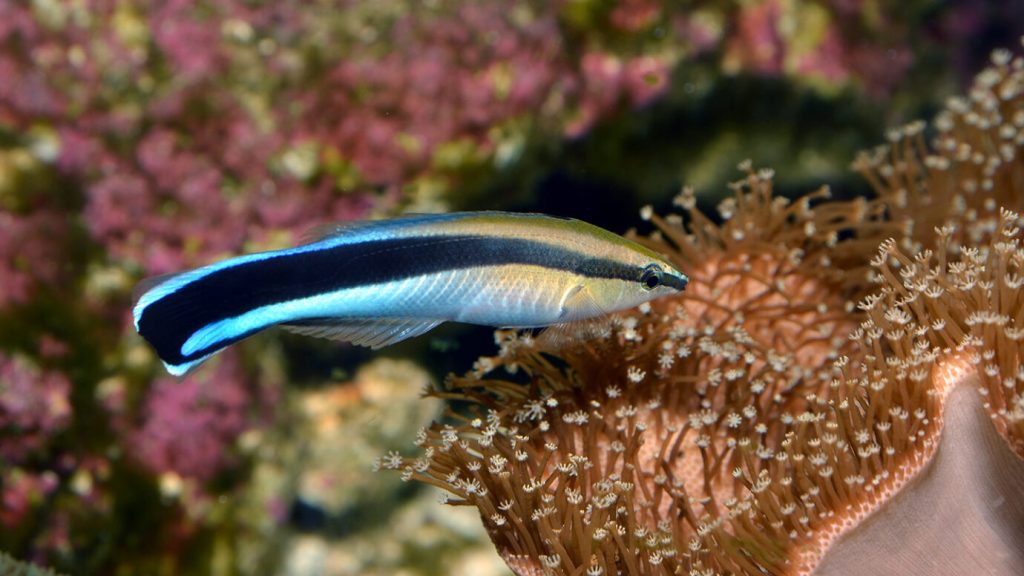Fish can recognize themselves in photos, further evidence they may be self-aware

Some fish can recognize their own faces in photos and mirrors, an ability usually attributed to humans and other animals considered particularly brainy, such as chimpanzees, scientists report. Finding the ability in fish suggests that self-awareness may be far more widespread among animals than scientists once thought.
“It is believed widely that the animals that have larger brains will be more intelligent than animals of the small brain,” such as fish, says animal sociologist Masanori Kohda of Osaka Metropolitan University in Japan. It may be time to rethink that assumption, Kohda says.
Kohda’s previous research showed that bluestreak cleaner wrasses can pass the mirror test, a controversial cognitive assessment that purportedly reveals self-awareness, or the ability to be the object of one’s own thoughts. The test involves exposing an animal to a mirror and then surreptitiously putting a mark on the animal’s face or body to see if they will notice it on their reflection and try to touch it on their body. Previously only a handful of large-brained species, including chimpanzees and other great apes, dolphins, elephants and magpies, have passed the test.
In a new study, cleaner fish that passed the mirror test were then able to distinguish their own faces from those of other cleaner fish in still photographs. This suggests that the fish identify themselves the same way humans are thought to — by forming a mental image of one’s face, Kohda and colleagues report February 6 in the Proceedings of the National Academy of Sciences.
“I think it’s truly remarkable that they can do this,” says primatologist Frans de Waal of Emory University in Atlanta who was not involved in the research. “I think it’s an incredible study.”
De Waal is quick to point out that failing the mirror test should not be considered evidence of a lack of self-awareness. Still, scientists have struggled to understand why some species that are known to have complex cognitive abilities, such as monkeys and ravens, have not passed. Researchers have also questioned whether the test is appropriate for species like dogs that rely more on scent, or like pigs that may not care enough about a mark on their bodies to try to touch it.
The mixed results in other animals make it all the more astonishing that a small fish can pass. In their first mirror test studies, published in 2019 and 2022, Kohda’s team exposed wild-caught cleaner fish in separate tanks to mirrors for a week. The researchers then injected brown dye just beneath the scales on the fish’s throats, making a mark that resembles the parasites these fish eat off the skin of larger fish in the wild. When the marked fish saw themselves in a mirror, they began striking their throats on rocks or sand in the bottom of the tank, apparently trying to scrape off the marks.
In the new study, 10 fish that passed the mirror test were then shown a photo of their own face and a photo of an unfamiliar cleaner fish face. All the fish acted aggressively toward the unfamiliar photo, as if it were a stranger, but were not aggressive toward the photo of their own face.
When another eight fish that had spent a week with a mirror but had not previously been marked were shown a photo of their own face with a brown mark on the throat, six of them began scraping their throats just like the fish that passed the mirror test. But they did not scrape when shown a photo of another fish with a mark.
Animals that recognize their reflection in the mirror most likely first learn to identify themselves by seeing that the movement of the animal in the mirror matches their own movement, researchers think. Because the cleaner fish were also able to recognize their own faces in still images, they, and possibly other animals that have passed the mirror test, may be able to identify themselves by developing a mental image of their own face that they can compare to what they see in the mirror or photos, the authors say.
“I think it’s a great next step,” says comparative cognitive psychologist Jennifer Vonk of Oakland University in Rochester, Mich., who wasn’t involved in the study. But she would like to see more research before drawing conclusions about what’s being represented in the mind of a nonverbal being like a fish. “As with most other studies, it still leaves some room for further follow-up.”
Kohda’s lab has more experiments planned to continue to probe what’s going on in the brain of the cleaner fish, and to try the new photo-recognition method on another popular research fish, the three-spined stickleback (Gasterosteus aculeatus).
Animal behaviorist Jonathan Balcombe, author of the book What a Fish Knows, is already convinced, describing the new study as “robust and quite brilliant.” People shouldn’t be surprised that fish could be self-aware given that they have already been shown to have complex behavior including tool use, planning and collaboration, Balcombe says. “It’s time we stopped thinking of fishes as somehow lesser members of the vertebrate pantheon.”